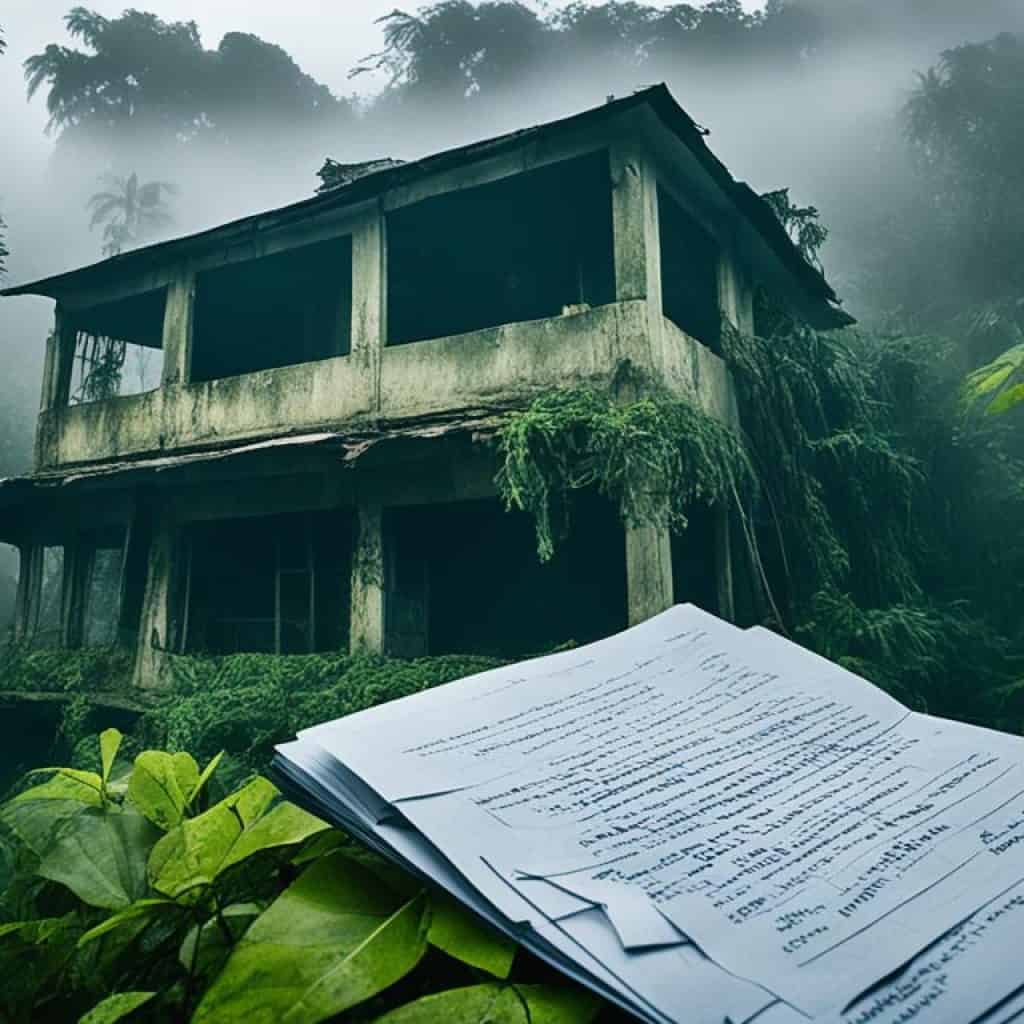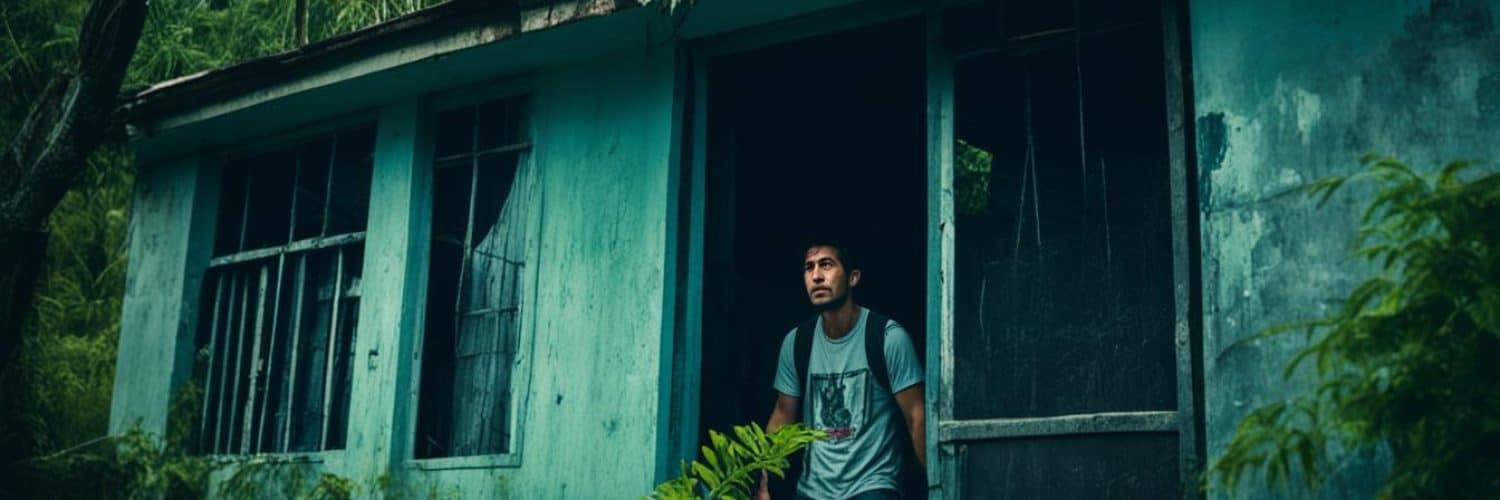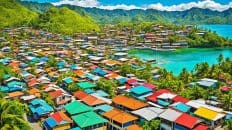Moving to a new country offers a wealth of excitement and opportunities, but what happens when expat dreams turn into nightmares? In the enchanting archipelago of the Philippines, expats have encountered their fair share of spine-tingling experiences that send shivers down their spines. From supernatural encounters to urban myths come to life, the expat community in the Philippines has stories that will make your blood run cold.
Are you ready to uncover the chilling tales from expats who have traversed the mysterious and sometimes treacherous path of expat life in the Philippines? Brace yourself as we delve into the darkest corners of the expat experience, exposing the lurking fears and cautionary lessons that await.
Key Takeaways:
- Discover cautionary tales from expats in the Philippines, shedding light on the challenges of living abroad in the country.
- Explore spine-tingling encounters with supernatural entities and urban myths that have circulated among locals and expats.
- Uncover the influence of Philippine folklore on the country’s speculative fiction genre.
- Learn about contemporary Filipino speculative fiction writers who infuse local myths and legends into their narratives.
- Gain practical tips for navigating expat life in the Philippines, from cultural adjustment to personal safety.
Taxi #45: A Terrifying Urban Myth from Davao City
In the realm of expat horror stories in the Philippines, urban myths and chilling tales circulate among both locals and expats themselves. One such spine-tingling urban myth that haunts Davao City is the ghastly tale of Taxi #45. Brace yourself for a bone-chilling encounter that serves as a cautionary tale about the potential horrors that await those who dare to enter the taxi cabs of the Philippines.
In this eerie tale, passengers recount their harrowing experience with a deformed taxi driver covered in blood. The sheer sight of the driver is enough to send shivers down your spine. As the story goes, unsuspecting passengers hail Taxi #45, unaware of the lurking nightmare that awaits them inside. Little do they know that behind the wheels of this cab resides a driver dredged from the depths of nightmares.
“Urban myths, as terrifying as they may be, often contain a grain of truth.”
This terrifying urban myth reminds us of the potential dangers that can arise when taking taxis in the Philippines. While the vast majority of taxi drivers are honest and reliable, caution is still paramount. It’s essential to stay vigilant, especially when hailing cabs late at night or in less crowded areas. Keeping friends and family informed about your whereabouts and using reputable ride-hailing services can further enhance your safety and peace of mind.
A Mischievous Poltergeist at Ateneo de Manila University
Ateneo de Manila University is renowned for its academic excellence and vibrant campus life. However, lurking within the halls of one particular building is a spine-chilling tale that has captivated the imagination of students and faculty alike. The Communications Building, steeped in history and surrounded by lush greenery, is rumored to be haunted by a mischievous poltergeist.
The legend unfolds with the story of a janitor who had an eerie encounter while performing his routine cleaning duties on the second floor. As he meticulously went about his tasks, he suddenly noticed a series of eerie handprints appearing on the mirrors, despite being the only person present at the time.
As if this wasn’t unsettling enough, the janitor soon discovered that strange occurrences were not limited to the mirrors alone. Objects would mysteriously move or fall off shelves, doors would inexplicably slam shut, and an unexplainable presence seemed to linger in the air.
This ominous tale serves as a reminder that supernatural experiences can transcend the boundaries of our everyday lives, even in the seemingly mundane setting of an academic institution. It is a testament to the rich tapestry of folklore and beliefs that shape the culture of the Philippines.
Spirited Encounters:
- Students sharing their encounters with the poltergeist
- The ongoing fascination with the haunted Communications Building
In the words of a student, “The stories may be unnerving, but they add to the allure and mystique of Ateneo. It’s like having our own ghost story to tell. It’s part of our university’s folklore, and we embrace it.”
While skeptics dismiss these experiences as mere tales, they cannot deny the lasting impression they have on the Ateneo community. Whether believers or not, the presence of a mischievous poltergeist at Ateneo de Manila University adds a touch of intrigue and mystery to the already captivating campus.
Explore the haunted stories of the Philippines and embark on a journey into the realms of the supernatural in our upcoming sections.
The White Lady of Loakan Road: A Haunting Urban Legend
Urban legends have the power to captivate our imaginations and leave us with an unshakeable sense of fear. In the Philippines, Baguio City is home to one such chilling tale â the legend of the White Lady of Loakan Road.
Passed down through generations, this haunted urban legend tells the story of a ghostly nurse who roams the dark and winding stretch of Loakan Road. According to locals, unsuspecting drivers have reported encountering a specter clad in a flowing white dress, standing by the roadside or even appearing suddenly in their vehicles. These sightings often leave witnesses paralyzed with fear.
This spine-tingling myth serves as a chilling reminder to be cautious when navigating the roads, especially at night. While the tale of the White Lady of Loakan Road may be steeped in lore and folklore, it strikes a nerve in the hearts of those who have heard it.

Ghostly Encounters and Haunted Highways
The White Lady haunts the desolate roads of Baguio City, a silent reminder of the mysterious and unexplained supernatural forces that dwell within our world.
The White Lady of Loakan Road is just one example of the eerie ghost stories that abound in the Philippines. The country’s rich culture and vibrant folklore give rise to countless urban legends and tales of the supernatural. These stories form an integral part of the country’s fabric, capturing the imagination of locals and expats alike.
A Word of Caution
Whether you believe in the paranormal or not, the legend of the White Lady of Loakan Road serves as a reminder to exercise caution when traveling on unfamiliar roads, especially in the late hours. While it may be tempting to dismiss such stories as mere fiction, it never hurts to err on the side of caution and stay vigilant.
Your Creepy Companion on the Road
The table below compiles some more spine-chilling urban legends from the Philippines, offering a glimpse into the haunting stories that have been passed down through generations:
| Urban Legend | Description |
|---|---|
| The Aswang | A creature of Philippine mythology known for its ability to shape-shift into different forms, such as a dog or a bat, it preys on unsuspecting victims. |
| The Tikbalang | A half-horse, half-human creature that lurks in the forests and mountains. It is believed to be a guardian of the environment. |
| The Kapre | A giant, cigar-smoking tree-dweller with long nails and shaggy hair. It is said to be a gentle creature but can be mischievous when provoked. |
These stories continue to captivate the fascination of both locals and expats alike, reminding us of the enduring power of myths and legends in shaping our cultural narratives.
A Terrifying Jeepney Ride in UP Diliman
Public transportation in the Philippines can be an adventure in itself, with jeepneys being a popular mode of transport. These colorful and iconic vehicles are known for their vibrant decorations and cramped interiors, but they also have their fair share of horror stories. One such tale comes from UP Diliman, where a student had a terrifying experience during a late-night jeepney ride.
As the student boarded the jeepney, they noticed something ominous about the passengers. Their faces were pale and expressionless, with vacant eyes that sent shivers down the student’s spine. Ignoring the unease, the student took a seat, hoping it was just their imagination running wild.
“Suddenly, the atmosphere inside the jeepney changed. It became stiflingly cold, and an eerie silence filled the air. I could feel a pair of eyes on me, and when I turned to look, I saw a ghostly figure in the shadows. It was a woman, dressed in white from head to toe, with long flowing hair that covered her face. She seemed to be staring directly at me, and my heart raced with fear.”
The student quickly realized that they were trapped in a jeepney with the infamous White Lady, a common urban legend in the Philippines. The White Lady is said to be a vengeful spirit, often appearing to unsuspecting victims, causing terror and unease.
As the ride continued, the student could hear whispers and mutterings coming from the other passengers, their words incomprehensible but filled with malice. Paralyzed with fear, the student desperately searched for an escape route, but found none.
Finally, with a surge of courage, the student shouted for the driver to stop. The jeepney screeched to a halt, and the student bolted out, gasping for breath and drenched in cold sweat. It was a narrow escape from a nightmare they never thought could be real.
This chilling jeepney tale serves as a stark reminder to always be cautious when using public transportation, especially in unfamiliar areas. While the majority of jeepney rides are uneventful and safe, it’s important to remain aware of your surroundings and trust your instincts if something feels off.
Jeepney Safety Tips:
- Choose well-lit and busy routes for your jeepney rides, especially during nighttime.
- If possible, travel with a companion to ensure added security.
- Keep your belongings close and avoid displaying valuables.
- Be cautious of strangers and trust your gut feeling if someone seems suspicious.
- If you feel uncomfortable or unsafe, don’t hesitate to get off at the nearest safe stop.
By staying vigilant and following these simple safety precautions, you can minimize the risk and have a safer commute while enjoying the unique experience of riding a jeepney in the Philippines.
| Pros | Cons |
|---|---|
| Convenient mode of transportation | Potential overcrowding |
| Affordable fares | Variable schedules and waiting times |
| Cultural experience | Limited seating space |
While jeepney rides can offer an authentic and budget-friendly way to navigate the Philippines, it’s important to prioritize your safety and be prepared for unexpected encounters, like the spine-chilling tale of the unidentified student in UP Diliman.
The Roots of Philippine Speculative Fiction
The genre of speculative fiction in the Philippines draws upon the rich tradition of myths, legends, and folklore that have been passed down through generations. These indigenous stories have laid the foundation for the development of Filipino speculative fiction, creating a unique storytelling landscape that is heavily influenced by Philippine culture and beliefs.
Filipino myths and legends are filled with fantastical creatures, magical beings, and supernatural occurrences. From the aswang, a shape-shifting creature, to the tikbalang, a half-horse, half-human creature, these mythical beings have captured the imaginations of generations and continue to inspire modern writers.
Philippine folklore is a tapestry of stories that reflect the values, customs, and history of the Filipino people. The tales of heroes like Bernardo Carpio and the adventures of the mythical creatures like the kapre and the diwata have become an integral part of the Filipino identity.
The influence of Philippine myths, legends, and folklore on speculative fiction can be seen in various forms. Authors often incorporate elements from these tales into their narratives, infusing their stories with a sense of cultural authenticity and familiarity. Whether it’s the use of supernatural creatures as characters or the exploration of themes related to Filipino spirituality and belief systems, these indigenous stories add depth and richness to Philippine speculative fiction.
Moreover, Philippine speculative fiction explores societal issues and challenges through the lens of fantasy and imagination. By blending reality with elements of the supernatural, authors are able to tackle social, political, and cultural topics in thought-provoking ways. This genre allows for reflection on the complexities of Filipino society while providing a platform for creative expression.
Overall, the roots of Philippine speculative fiction lie deep within the country’s myths, legends, and folklore. These indigenous stories have not only shaped the genre but have also influenced the perspectives and narratives of Filipino speculative fiction writers. By embracing their cultural heritage and weaving it into their stories, these authors have created a vibrant and captivating genre that continues to evolve and inspire.
Contemporary Filipino Speculative Fiction Writers
Within the realm of horror and fantasy literature, talented Filipino writers have emerged, bringing their unique perspective and storytelling abilities to captivate readers. These contemporary authors have made significant contributions to the speculative fiction genre, infusing their narratives with local folklore and mythologies, creating a rich tapestry of imaginative tales.
One notable Filipino writer in the horror genre is Dean Francis Alfar. With his collection of short stories titled “How to Traverse Terra Incognita,” Alfar explores the dark corners of the human psyche, blending elements of horror, fantasy, and magical realism to craft haunting and thought-provoking narratives.
| Writer | Genre | Notable Works |
|---|---|---|
| Dean Francis Alfar | Horror, Fantasy, Magical Realism | “How to Traverse Terra Incognita” |
| Yvette Tan | Horror | “Waking the Dead: A Horror Anthology” |
| Eliza Victoria | Horror, Speculative Fiction | “Dwellers” |
| Anna Felicia Sanchez | Fantasy | “The Dragon’s Secret” |
Yvette Tan is another respected Filipino writer who excels in the horror genre. Her anthology “Waking the Dead: A Horror Anthology” showcases her talent for crafting chilling and macabre stories that explore the mysteries and terrors that lurk within the shadows.
Eliza Victoria is known for her contributions to both the horror and speculative fiction genres. Her novel “Dwellers” delves into the supernatural, exploring the horrors that inhabit the unseen corners of society and the human mind. Victoria’s blending of genres creates a unique reading experience that keeps audiences on the edge of their seats.
Anna Felicia Sanchez, on the other hand, stands out in the fantasy genre. Her novel “The Dragon’s Secret” presents a captivating tale of mythical creatures and magical realms. Sanchez’s storytelling abilities weave together folklore and fantasy elements, transporting readers to enchanting worlds beyond imagination.
These contemporary Filipino speculative fiction writers, among others, have skillfully carved their niche in the literary world. Their work showcases the rich storytelling traditions of the Philippines and offers readers a captivating blend of horror, fantasy, and the supernatural.

Exploring the Dark Side of Philippine Folklore
In this section, we delve into the dark and sinister side of Philippine folklore, where mystic creatures and legendary beings roam. These creatures, known as aswang, tikbalang, and kapre, have long been the subject of frightening tales and are integral to many Filipino horror stories.
Mysterious Aswang
One of the most infamous creatures in Philippine folklore is the aswang. This shape-shifting monster is said to have the ability to transform into various animals, such as a bat or a dog, to deceive its victims. It is often depicted as a blood-sucking creature, preying on unsuspecting individuals, especially children.
Aswang stories have been passed down through generations, instilling fear in the hearts of Filipino communities. These tales warn of the dangers that lurk in the darkness, reminding us to always remain vigilant.
Terrifying Tikbalang
The tikbalang is a mythical creature that is part human and part horse. It is known for its long limbs and horse-like head, often described as a creature of immense strength and malevolence. Legend has it that encountering a tikbalang can bring great misfortune, leading travelers astray and causing them to lose their way.
This eerie creature is deeply ingrained in Philippine folklore, and tikbalang stories serve as cautionary tales for those who dare to wander into the unknown, reminding us to be cautious and mindful of our surroundings.
Enigmatic Kapre
The kapre is a giant, cigar-smoking creature that resides in trees, often depicted as a towering figure with glowing red eyes. It is believed to have the power to control the minds of humans and possesses great strength. Kapre stories often warn against venturing too close to dense forests or old trees, as it is said that these creatures can cast spells and capture unsuspecting victims.
These captivating tales of kapres remind us of the importance of respecting nature and the boundaries that lie within it.
“The creatures of Philippine folklore embody the unexplainable and mysterious aspects of our culture. They serve as reminders of the supernatural forces that exist alongside us, cautioning us to remain wary and respectful of the unknown.”
| Mythological Creature | Description |
|---|---|
| Aswang | A shape-shifting creature that preys on unsuspecting individuals, often depicted as a blood-sucking monster. |
| Tikbalang | A creature that is part human and part horse, known for leading travelers astray and causing them to lose their way. |
| Kapre | A giant, cigar-smoking creature that resides in trees and possesses mind control abilities, often warning against venturing too close to forests or old trees. |
Merging Fantasy and Reality in Philippine Literature
Filipino literature is a captivating blend of fantasy and reality that showcases the unique storytelling traditions of the Philippines. One genre that exemplifies this fusion is magical realism, which seamlessly combines elements of the fantastical with the everyday. Through this literary approach, Filipino writers create narratives that reflect the complexities of Filipino society and offer readers a glimpse into a world where the boundaries between reality and imagination blur.
Magical realism is a literary style that originated in Latin America and has found a home in Philippine literature. It is characterized by the inclusion of magical or supernatural elements within an otherwise realistic setting. This blending of the ordinary and the extraordinary allows authors to explore social and political issues in a thought-provoking and metaphorical way.
One prominent Filipino writer known for his masterful use of magical realism is Gabriel Garcia Marquez, the author of the renowned novel One Hundred Years of Solitude. In the realm of Philippine literature, authors like Miguel Syjuco and F.H. Batacan have embraced magical realism to present narratives that challenge conventional storytelling norms and invite readers to reimagine reality.
Magical realism in Philippine literature serves as a vehicle for addressing various themes and concerns. It allows writers to delve into the country’s rich mythologies, folklore, and history, infusing these elements seamlessly into their storytelling. By merging fantasy and reality, authors can explore cultural identity, social issues, and the intricacies of human relationships in a way that is both imaginative and relatable.
“Magical realism opens a door into a world where the extraordinary and the ordinary coexist. It allows us to see our reality from a different perspective, questioning the boundaries we often take for granted.”
Magical realism also offers readers a unique reading experience, immersing them in a narrative that defies traditional conventions. By incorporating elements of fantasy and the supernatural, authors create a sense of wonder and intrigue, transforming the familiar into something extraordinary.
To illustrate the impact of magical realism in Philippine literature, here is a table showcasing some notable works and authors that have embraced this genre:
| Book | Author |
|---|---|
| Ilustrado | Miguel Syjuco |
| Smaller and Smaller Circles | F.H. Batacan |
| When the Elephants Dance | Tess Uriza Holthe |
These works transport readers to worlds where reality and the miraculous coexist, urging them to question their perceptions of what is possible. Through the lens of magical realism, Filipino authors invite readers to explore the depths of their imaginations while providing insight into the multifaceted nature of the Philippines.
The Influence of Magical Realism on Filipino Literature
The genre of magical realism has profoundly influenced Filipino literature by enabling authors to infuse their works with elements of the fantastical and the supernatural. By merging fantasy and reality, these writers construct narratives that resonate with readers on a deeply emotional and imaginative level.
Through the integration of magical realism, Filipino literature continues to evolve, offering a diverse range of stories that celebrate the country’s cultural heritage, challenge societal norms, and explore the complexities of human existence.
Continue reading to discover the impact of Philippine horror movies on the country’s storytelling traditions.
The Impact of Philippine Horror Movies
Philippine horror movies have had a profound influence on the country’s popular culture and the storytelling traditions of Filipino horror writers. These movies, known for their unique blend of horror, suspense, and folklore, have captivated audiences and left a lasting impact on the Philippine cinema landscape. Pinoy horror movies have not only terrified audiences but also shaped the horror genre in the Philippines.
One of the notable aspects of Philippine horror films is their incorporation of local myths, legends, and supernatural creatures. Filipino directors and writers have drawn inspiration from Philippine folklore to create stories that resonate with the audience on a cultural level. By infusing these elements into their narratives, Philippine horror movies have successfully showcased the rich and diverse folklore of the country, gaining popularity both domestically and internationally.
“Philippine horror movies are a celebration of our culture’s fascination with the supernatural. They provide a platform for us to explore our deepest fears and beliefs, while also entertaining and thrilling audiences.”
These horror films have also played a significant role in shaping the career paths of Filipino horror writers. Many renowned Filipino authors have found inspiration in the themes, storytelling techniques, and visual aesthetics of Philippine horror movies. The influence of Pinoy horror films can be seen in the works of contemporary Filipino horror writers, who continue to craft terrifying tales steeped in Philippine folklore, traditions, and superstitions.
Furthermore, the success of Philippine horror movies has paved the way for the recognition and appreciation of Filipino talent in the global film industry. Filipino filmmakers, directors, and actors have gained international acclaim for their contributions to the horror genre. The unique blend of horror and folklore found in Philippine horror movies has drawn attention and admiration from horror enthusiasts around the world.

The impact of Philippine horror movies extends beyond the realm of cinema. These movies have become cultural touchstones, ingrained in the collective memory of Filipinos. They have become a part of the shared experiences and conversations among friends and family, sparking discussions, debates, and even urban legends centered around the terrifying moments portrayed on the screen.
In conclusion, Philippine horror movies have played a pivotal role in shaping the horror genre in the country, showcasing the richness of Philippine folklore and influencing the storytelling traditions of Filipino horror writers. These movies have not only terrified audiences but have also propelled Filipino filmmakers and actors onto the global stage. The impact of Pinoy horror movies on popular culture and the creative industry is undeniable, solidifying their place in the annals of Philippine cinema.
Navigating Expat Life in the Philippines
Living as an expat in the Philippines can be an exciting and rewarding experience. However, it also comes with its own unique set of challenges. Whether you are considering moving to the Philippines or have already made the leap, here are some practical tips and advice to help you navigate expat life in this beautiful country.
Cultural Adjustment
Adjusting to a new culture can be both fascinating and overwhelming. Embrace the vibrant Filipino culture by immersing yourself in local traditions, festivals, and cuisine. Take the time to learn some basic Filipino phrasesâit will go a long way in building relationships with locals. Remember to respect local customs and traditions to foster positive interactions.
Personal Safety
Like in any country, personal safety is paramount. Familiarize yourself with the safety precautions and be cautious when traveling alone, especially at night. Stick to well-lit and populated areas, and use reputable transportation services. Stay informed about current safety concerns and follow the advice of local authorities.
Healthcare
Ensuring access to quality healthcare is crucial. Familiarize yourself with healthcare providers and facilities in your area. It is recommended to have a comprehensive health insurance plan that covers both emergency and non-emergency medical services. Maintain a healthy lifestyle, practice good hygiene, and be proactive in seeking medical care when needed.
Building a Support Network
Building a strong support network within the expat community can greatly enhance your experience. Attend local expat events, join expat groups or online forums to connect with like-minded individuals. Share your experiences, seek advice, and form friendships with fellow expats who understand the unique challenges of living abroad.
“Having a support system of other expats has been invaluable during my time in the Philippines. They have provided guidance, shared their experiences, and made me feel like a part of a community even when I’m far from home.”
Embracing the Beauty of the Philippines
Despite the horror stories, the Philippines is a beautiful country with numerous tourist destinations and natural wonders to explore. From stunning beaches to breathtaking landscapes, the Philippines offers a diverse range of attractions that cater to every traveler’s interests.
Must-Visit Tourist Destinations
When it comes to travel in the Philippines, there are several destinations that should be on every expat’s itinerary. Whether you’re seeking relaxation, adventure, or cultural immersion, these places offer something for everyone:
- Boracay Island: Known for its powdery white beaches and crystal-clear waters, Boracay is a popular destination for beach lovers and water sports enthusiasts.
- Puerto Princesa Underground River: Explore one of the New Seven Wonders of Nature and marvel at the beauty of the Puerto Princesa Underground River, located in Palawan.
- Chocolate Hills: Visit Bohol and witness the unique geological formations known as the Chocolate Hills. These hills turn brown during the dry season, resembling chocolate kisses.
- Mayon Volcano: Experience the majestic Mayon Volcano in Albay. Known for its perfect cone shape, this active stratovolcano offers stunning views and challenging hikes.
- Rice Terraces of Banaue: Journey to the north and witness the awe-inspiring rice terraces of Banaue, a UNESCO World Heritage Site. These terraces are a testament to the ingenuity of the indigenous Ifugao people.
These are just a few examples of the many incredible destinations the Philippines has to offer. Whether you’re exploring the pristine beaches, diving in vibrant coral reefs, or immersing yourself in the rich cultural heritage, there is always something new to discover in this tropical paradise.
Natural Wonders of the Philippines
The natural wonders of the Philippines are unparalleled, showcasing the country’s diverse and breathtaking landscapes. From towering mountains to underground rivers, here are some of the remarkable natural wonders that await you:
- Taal Volcano: Located in Batangas, Taal Volcano is one of the world’s smallest active volcanoes and sits within a picturesque lake. It offers a unique hiking experience with stunning panoramic views.
- Tubbataha Reefs Natural Park: Dive into the pristine waters of Tubbataha Reefs Natural Park, a UNESCO World Heritage Site known for its vibrant coral reefs and diverse marine life.
- Hundred Islands National Park: Explore the stunning Hundred Islands National Park, an archipelago of 124 islands and islets located in Pangasinan. Swim, snorkel, or go island hopping in this natural wonder.
- Hinatuan Enchanted River: Experience the enchanting beauty of the Hinatuan Enchanted River in Surigao del Sur. Its crystal-clear blue waters and mystical aura make it a must-visit destination.
- Mount Apo: Scale the highest peak in the Philippines, Mount Apo. Located in Mindanao, this majestic mountain offers breathtaking views and challenging trails for avid hikers.
These natural wonders are just a glimpse of the Philippines’ stunning landscapes. Whether you’re a nature lover, adventurer, or simply seeking tranquility, the country’s natural wonders will leave you in awe.
“The Philippines’ beauty is unparalleled, offering diverse landscapes and attractions that cater to every traveler’s interests. From pristine beaches to captivating natural wonders, this country is a treasure trove waiting to be explored.” – Travel enthusiast
| Tourist Destination | Location | Attractions |
|---|---|---|
| Boracay Island | Aklan | White Beach, Water Sports, Island Hopping |
| Puerto Princesa Underground River | Palawan | Underground River Tour, Stalactite Formations |
| Chocolate Hills | Bohol | Unique Geological Formations, Viewing Deck |
| Mayon Volcano | Albay | Volcano Trekking, ATV Adventure |
| Rice Terraces of Banaue | Ifugao | Trekking, Cultural Immersion |
Conclusion
In conclusion, the expat horror stories from the Philippines serve as cautionary tales for those considering living in the country. These stories highlight the challenges and potential dangers that expats may encounter during their time in the Philippines. It is essential to approach expat life in the Philippines with caution and preparedness.
However, it is important to remember that every expat experience is unique. While some expats may have encountered negative situations, it is crucial to recognize that not all encounters will be the same. There are countless expats who have had positive and enriching experiences while living in the Philippines.
By learning from the experiences shared in these horror stories, expats can navigate expat life in the Philippines with more confidence. They can take note of the lessons learned by others and be better prepared for the challenges that may arise. It is also essential for expats to build a strong support network within the expat community, as they can provide valuable advice and assistance.
Despite the cautionary tales, expats should also remember to embrace the beauty of the Philippines. The country is home to breathtaking tourist destinations and natural wonders that can be explored and enjoyed. With the right mindset and preparation, expats can have a fulfilling and rewarding experience living in the Philippines.
FAQ
What are some expat horror stories from the Philippines?
The article explores cautionary tales from expats in the Philippines, highlighting their experiences and providing insights into expat life in the country. The stories serve as a warning and offer valuable lessons for those considering moving to or living in the Philippines as an expat.
What is the urban myth of Taxi #45 in Davao City?
Taxi #45 is an urban myth that circulates among locals and expats in Davao City. It recounts a terrifying encounter with a deformed driver covered in blood, serving as a cautionary tale about the potential dangers of taking taxis in the Philippines.
Is Ateneo de Manila University haunted?
The Communications Building at Ateneo de Manila University is rumored to be haunted by a mischievous poltergeist. The story involves a janitor who encounters eerie handprints and strange occurrences while cleaning the second-floor restroom, reminding us that supernatural experiences can happen even in academic settings.
What is the White Lady of Loakan Road in Baguio City?
The White Lady of Loakan Road is a well-known urban legend in Baguio City. The story revolves around a ghostly nurse who haunts the area, appearing to unsuspecting drivers. This chilling tale serves as a reminder to be wary of picking up hitchhikers or encountering supernatural entities on the road.
Are public transportation encounters dangerous in the Philippines?
A student’s harrowing experience on a late-night jeepney ride in UP Diliman serves as a cautionary tale about the potential dangers of taking public transportation in unfamiliar areas. The story highlights the importance of personal safety and being aware of one’s surroundings when using public transportation in the Philippines.
How has Philippine folklore influenced literature in the country?
The rich tradition of Philippine myths, legends, and folklore has served as the foundation of the country’s speculative fiction genre. The article explores how these indigenous stories have shaped the storytelling landscape in the Philippines and influenced the development of Filipino speculative fiction writers.
Who are some contemporary Filipino speculative fiction writers?
The article highlights the works of contemporary Filipino speculative fiction writers who have contributed to the horror and fantasy genres. These authors bring a unique Filipino perspective to their storytelling, infusing local folklore and myths into their narratives.
What are some mythological creatures from Philippine folklore?
The dark side of Philippine folklore is explored in this section, focusing on mythological creatures known as aswang, tikbalang, and kapre. These creatures are often associated with horror and are prominently featured in many Filipino horror stories.
Does Filipino literature incorporate elements of fantasy?
Filipino literature often blurs the line between fantasy and reality, embracing the genre of magical realism. This section explores how Filipino writers have merged elements of fantasy and reality in their works, creating unique narratives that reflect the complexities of Filipino society.
What is the impact of Philippine horror movies?
Philippine horror movies have played a significant role in shaping the horror genre in the country. This section highlights the impact of Philippine horror movies on popular culture and how they have influenced the storytelling traditions of Filipino horror writers.
What tips are provided for expats living in the Philippines?
This section provides practical tips and advice for expats living in the Philippines. It covers topics such as cultural adjustment, personal safety, healthcare, and building a support network within the expat community.


















Add comment